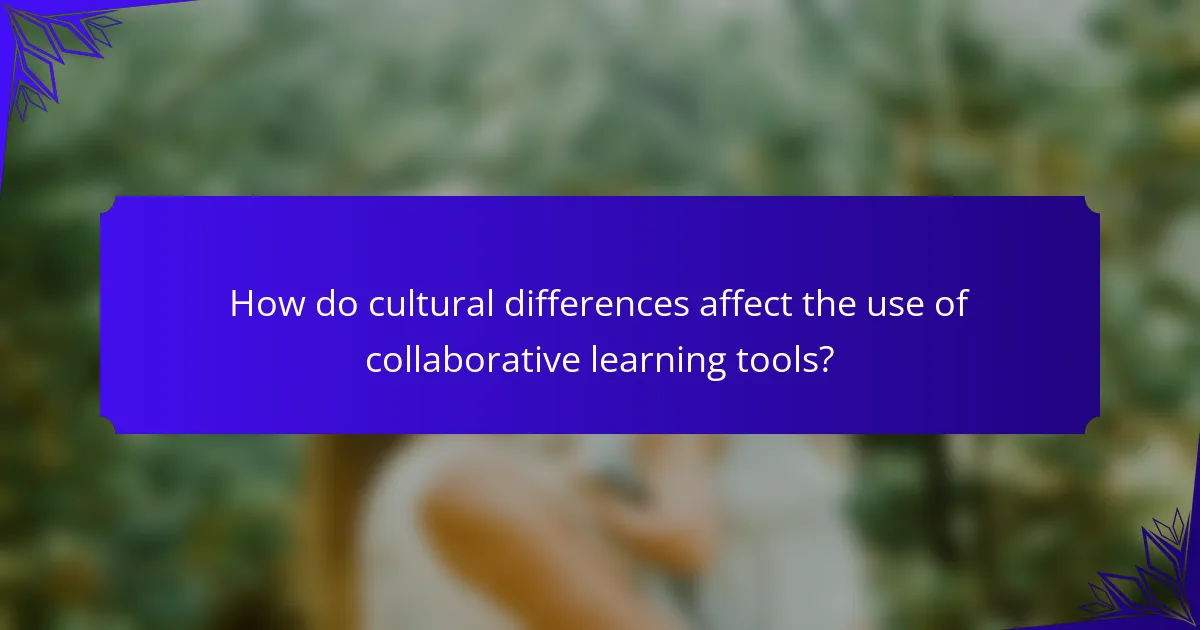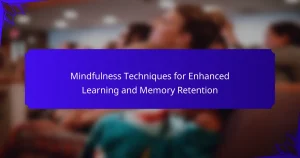Collaborative learning tools enhance engagement and teamwork among participants through effective communication and shared resources. They offer real-time collaboration, document sharing, and analytics for performance insights. Understanding cultural influences can improve tool effectiveness, while avoiding common pitfalls ensures clear objectives and structured guidelines for all users. Best practices in utilizing these tools can significantly elevate the learning experience.

What are the core features of collaborative learning tools?
Collaborative learning tools enhance teamwork and engagement through shared resources and communication features. Key features include real-time collaboration, document sharing, discussion forums, and task management. These tools foster interactivity, allowing users to contribute and learn from one another effectively. Additionally, analytics and feedback mechanisms provide insights into group performance, promoting continuous improvement.
How do collaborative learning tools enhance student engagement?
Collaborative learning tools significantly enhance student engagement by fostering interaction and teamwork. These tools promote active participation, allowing students to share ideas and solve problems collectively. As a result, students develop critical thinking and communication skills while feeling more connected to their peers. Collaborative platforms, such as discussion forums and group projects, facilitate diverse perspectives, increasing motivation and accountability among learners. Engaging with these tools can lead to improved academic performance and a deeper understanding of the subject matter.
What types of collaborative learning tools are most effective?
Collaborative learning tools that foster engagement include discussion forums, project management software, and interactive whiteboards. These tools enhance communication, organization, and creativity among participants.
Discussion forums allow for asynchronous communication, enabling participants to share ideas at their convenience. Project management software streamlines task assignment and tracking, promoting accountability and collaboration. Interactive whiteboards facilitate real-time brainstorming, allowing users to visualize concepts collectively.
Incorporating these tools can lead to improved learning outcomes and a more connected learning environment. Their effectiveness lies in their ability to adapt to various learning styles and team dynamics.
What are the differences between synchronous and asynchronous tools?
Synchronous tools enable real-time collaboration, while asynchronous tools allow for delayed interaction. Synchronous tools, like video conferencing, require participants to be present simultaneously, fostering immediate feedback and engagement. In contrast, asynchronous tools, such as discussion forums, offer flexibility, allowing users to contribute at their convenience. This distinction influences user experience and engagement strategies in collaborative learning environments.
How do document-sharing platforms facilitate collaboration?
Document-sharing platforms enhance collaboration by enabling real-time access, editing, and feedback among users. They streamline communication, allowing teams to work together efficiently from different locations. Features like version control ensure that everyone is on the same page, reducing errors and miscommunication. Additionally, integration with other collaborative tools amplifies engagement and productivity.
What role do communication tools play in collaborative learning?
Communication tools are essential in collaborative learning as they enhance interaction and engagement among participants. These tools facilitate real-time discussions, resource sharing, and feedback, promoting a more inclusive learning environment. Effective communication tools, such as video conferencing and collaborative platforms, lead to improved understanding and retention of information. As a result, learners can work together more efficiently, leveraging diverse perspectives to achieve common goals.
How can video conferencing tools improve group dynamics?
Video conferencing tools enhance group dynamics by fostering communication and collaboration. They enable real-time interactions, which build trust and rapport among team members. Features like screen sharing and breakout rooms promote engagement and active participation, ensuring that all voices are heard. Furthermore, these tools support diverse learning styles, making it easier for participants to connect and contribute effectively.
What are the benefits of instant messaging in learning environments?
Instant messaging enhances collaborative learning by facilitating real-time communication and engagement among students. It promotes immediate feedback, encourages participation, and fosters a sense of community. This tool supports diverse learning styles, allowing for quick sharing of resources and ideas. As a result, students experience improved academic performance and motivation.

What unique advantages do collaborative learning tools offer?
Collaborative learning tools provide unique advantages by enhancing engagement, improving communication, and fostering teamwork. They facilitate real-time interaction, allowing learners to share ideas and resources effectively. This collaborative environment promotes critical thinking and creativity, essential for problem-solving. Additionally, these tools often support diverse learning styles, accommodating individual preferences while building a sense of community among participants.
How do these tools foster critical thinking and problem-solving skills?
Collaborative learning tools enhance critical thinking and problem-solving skills by promoting active engagement and peer interaction. These tools encourage diverse perspectives, allowing learners to analyze problems collectively. As a result, students develop reasoning abilities and adaptability through collaboration. Research shows that group discussions and shared tasks lead to improved decision-making skills and deeper understanding of complex concepts.
What impact do collaborative learning tools have on diverse learning styles?
Collaborative learning tools positively impact diverse learning styles by fostering engagement and inclusivity. These tools accommodate visual, auditory, and kinesthetic learners, enhancing participation and retention. For example, platforms that support multimedia resources cater to visual learners, while discussion forums engage auditory learners through dialogue. Additionally, hands-on activities within collaborative tools benefit kinesthetic learners. As a result, these tools create a dynamic learning environment that promotes collaboration and understanding among students with varying preferences.

What rare attributes can enhance the effectiveness of collaborative learning tools?
Rare attributes that can enhance the effectiveness of collaborative learning tools include adaptability, which allows tools to adjust to diverse learning styles, and real-time feedback capabilities that facilitate immediate improvement. Additionally, integration with various platforms can create seamless user experiences, while gamification elements can increase engagement and motivation. These unique features can significantly elevate collaborative learning experiences.
How can gamification elements improve engagement in collaborative tools?
Gamification elements significantly enhance engagement in collaborative tools by making learning more interactive and enjoyable. Incorporating features like points, badges, and leaderboards motivates users to participate actively. These elements foster a sense of achievement and community, which can lead to increased collaboration and knowledge sharing among users. As a result, engagement levels rise, driving better outcomes in collaborative learning environments.
What innovative features are emerging in collaborative learning tools?
Innovative features in collaborative learning tools include real-time editing, AI-driven analytics, and integrated communication channels. These advancements enhance user engagement and streamline group interactions, making learning more effective. For example, AI analytics can provide insights into participation levels, helping educators tailor their approaches. Additionally, gamification elements foster motivation and collaboration among users.

How do cultural differences affect the use of collaborative learning tools?
Cultural differences significantly influence the effectiveness of collaborative learning tools. These tools often rely on communication styles and group dynamics shaped by cultural backgrounds. For instance, cultures that value individualism may prioritize personal contributions, while collectivist cultures may emphasize group harmony and consensus. Understanding these differences can enhance engagement and collaboration, tailoring tools to meet diverse needs.
What are the best practices for implementing collaborative learning tools in diverse classrooms?
Collaborative learning tools enhance engagement in diverse classrooms by promoting inclusivity and interaction. Best practices include establishing clear objectives, providing training for educators, and fostering a supportive environment. Regular feedback and varied activities cater to different learning styles, ensuring all students participate effectively. Utilizing technology thoughtfully can also bridge gaps in communication and collaboration among students.

What common mistakes should educators avoid when using collaborative learning tools?
Educators should avoid common mistakes such as unclear objectives, lack of structure, insufficient training, and neglecting individual accountability. These pitfalls can hinder the effectiveness of collaborative learning tools, reducing engagement and learning outcomes. Clear goals and structured guidelines ensure that all participants understand their roles. Training helps educators utilize tools effectively, while accountability encourages active participation from all members.
How can instructors optimize the use of collaborative learning tools for better outcomes?
Instructors can optimize collaborative learning tools by fostering an inclusive environment and encouraging active participation. Effective practices include setting clear goals, providing structured guidance, and utilizing diverse tools to cater to different learning styles.
Incorporating techniques such as peer feedback and reflective discussions enhances engagement and deepens understanding. Moreover, leveraging analytics from these tools can help instructors assess participation and outcomes, allowing for timely adjustments to strategies.
Ultimately, the success of collaborative learning hinges on creating a supportive atmosphere that values each participant’s contribution. This approach not only boosts engagement but also improves overall learning outcomes.
What expert insights can guide effective engagement strategies with these tools?
Effective engagement strategies with collaborative learning tools include fostering a sense of community, promoting active participation, and utilizing diverse content formats. Prioritize clear communication to enhance collaboration. Incorporate feedback mechanisms to adapt strategies based on user experience. Leverage technology features to facilitate real-time interaction, ensuring that all participants feel valued.


